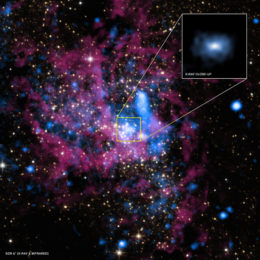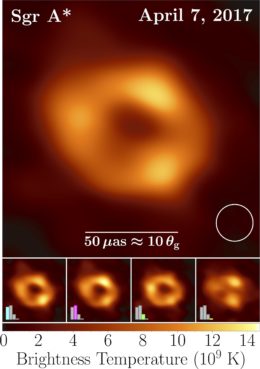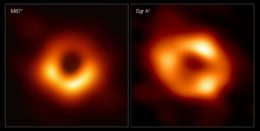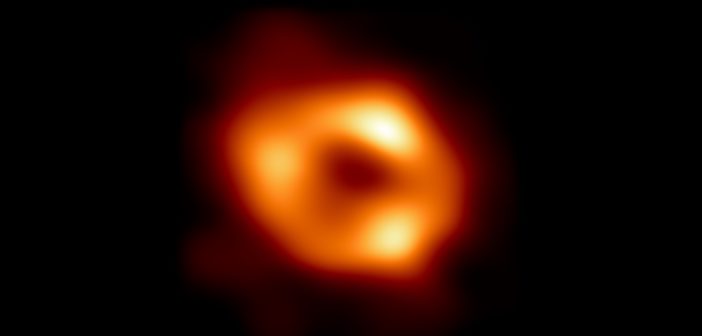In 2019, the Event Horizon Telescope collaboration published an image of the supermassive black hole at the center of the galaxy Messier 87 — the first image of its kind ever created. Now, the long-awaited first image of the Milky Way’s central supermassive black hole has been released. The results of this international endeavor are summarized in a new Focus Issue of The Astrophysical Journal Letters.
A Black Hole Bonanza

This composite (blue) and infrared (red and yellow) view shows the crowded environment of the galactic center. The close-up X-ray view of the innermost half light-year zooms in on Sgr A*. [X-ray: NASA/UMass/D.Wang et al., IR: NASA/STScI]
The EHT is a global network of radio dishes stretching from Antarctica to Spain that can be combined to make a planet-size telescope. In April 2017, eight telescopes in six locations around the world collected the faint radio emission from Sgr A*, Messier 87’s central black hole (M87*), and a handful of other objects. The images of M87* released in 2019 helped us to determine this black hole’s mass, spin, and orientation, and they provided a valuable test of how massive objects bend spacetime.

Messier 87, located 53 million light-years away, emits a powerful jet of electrons and other particles in this visible-light image from the Hubble Space Telescope. [NASA and The Hubble Heritage Team (STScI/AURA)]
Sgr A*’s size and location create some unique observational challenges. Because Sgr A* is much smaller than M87*, our black hole’s appearance can change on much faster timescales, leading to hourly brightness variations that made processing the EHT data challenging. On top of that variability, there’s the difficulty of viewing angle: to observe Sgr A*, the researchers had to peer through 27,000 light-years of gas and dust between Earth and the galactic center. How did the EHT collaboration handle these challenges, and what do the resulting images tell us?
Inspecting Images

Image of Sgr A* constructed from observations made on April 7, 2017. The bottom row shows average images derived using different data-processing techniques and the prevalence of each morphology (bar graphs in lower-left corners). These images do not show the time variability of Sgr A*. Click to enlarge. [EHT Collaboration et al. 2022]
The articles published today focus on the best set of observations, which were taken on April 7, 2017. An image created from these data reveals a bright, asymmetrical ring of emission from the superheated gas that orbits the black hole. At the center of the ring is a dark region called the shadow, which contains the black hole’s event horizon — the surface beyond which nothing, not even light, can escape the black hole’s grasp.
These stunning images provide the first visual confirmation that the massive object at the center of the Milky Way is indeed a black hole. The diameter of the ring — 51.8 microarcseconds, encircling a shadow with a diameter of 48.7 microarcseconds — precisely matches the predictions of the general theory of relativity for a black hole four million times as massive as the Sun, providing yet another validation of this leading theory of gravity.
Modeling a Massive Black Hole
After constructing the images, the team used models to explore conditions close to Sgr A*, determine the black hole’s properties, and test theories of gravity. Overall, the simulations match the observations beautifully, with models that incorporate strong magnetic fields, involve a moderate rate of spin, and place Sgr A* at a slight angle relative to our line of sight matching the observations best.

Left: Snapshot of a simulation of the emission from Sgr A* that matched all but one of the team’s observational criteria. Center: The same simulation, but time-averaged to match the EHT observing cadence. Right: Simulated EHT image based on the modeling results. Click to enlarge. [EHT Collaboration et al. 2022]
The team also used the decrease in brightness at the center of the ring to constrain the nature of Sgr A*. The brightness decrease is consistent with the presence of a black hole with an event horizon and specifically rules out several exotic black-hole alternatives like naked singularities, boson stars, and certain types of wormholes.
Looking Ahead

Side-by-side comparison of the angular sizes (how large objects appear on the sky) of M87* (left) and Sgr A* (right). [EHT Collaboration]
Though the EHT’s results give definitive answers to many questions about the Milky Way’s central black hole, many questions about supermassive black holes remain. How do supermassive black holes like M87* create their particle jets? Do supermassive black holes hinder star formation in the galaxies they inhabit, or do they spur it onward? And how and when did supermassive black holes form in the first place?
Future analysis of the EHT observations will delve into the structure of the magnetic field near Sgr A*, as well as investigate structural changes that may have accompanied a flare that was seen at X-ray wavelengths on the final day of EHT observations.

Locations of the telescopes used to create the Sgr A* images (yellow symbols) as well as the facilities added to the EHT array after 2018 (blue symbols). Click to enlarge. [ESO/M. Kornmesser; CC BY 4.0]
For more information, check out the full ApJL Focus Issue here: Focus Issue on First Sgr A* Results from the Event Horizon Telescope
Citation
“First Sagittarius A* Event Horizon Telescope Results. I. The Shadow of the Supermassive Black Hole in the Center of the Milky Way,” EHT Collaboration et al 2022 ApJL 930 L12. doi:10.3847/2041-8213/ac6674

